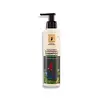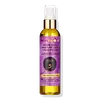What's inside
What's inside
 Benefits
Benefits

 Concerns
Concerns

 Ingredients Side-by-side
Ingredients Side-by-side

Water
Skin ConditioningSodium Cocoyl Isethionate
CleansingCocamidopropyl Betaine
CleansingSodium Lauroyl Sarcosinate
CleansingGlycol Distearate
EmollientCapryloyl/Caproyl Methyl Glucamide
EmulsifyingLauroyl/Myristoyl Methyl Glucamide
EmollientPEG-150 Distearate
EmulsifyingPEG-12 Dimethicone
Skin ConditioningDipropylene Glycol
HumectantPolysilicone-29
Bis-Cetearyl Amodimethicone
Polyquaternium-7
Coco-Glucoside
CleansingGlyceryl Oleate
EmollientSerenoa Serrulata Fruit Extract
Skin ConditioningPhenoxyethanol
PreservativeParfum
MaskingQuaternium-98
EmollientPolyquaternium-113
Stearamidopropyl Dimethylamine
EmulsifyingCitric Acid
BufferingCetrimonium Chloride
AntimicrobialArgania Spinosa Kernel Oil
EmollientOenocarpus Bataua Fruit Oil
EmollientHydrolyzed Keratin
HumectantHydrolyzed Plukenetia Volubilis Seed Extract
Emulsion StabilisingWater, Sodium Cocoyl Isethionate, Cocamidopropyl Betaine, Sodium Lauroyl Sarcosinate, Glycol Distearate, Capryloyl/Caproyl Methyl Glucamide, Lauroyl/Myristoyl Methyl Glucamide, PEG-150 Distearate, PEG-12 Dimethicone, Dipropylene Glycol, Polysilicone-29, Bis-Cetearyl Amodimethicone, Polyquaternium-7, Coco-Glucoside, Glyceryl Oleate, Serenoa Serrulata Fruit Extract, Phenoxyethanol, Parfum, Quaternium-98, Polyquaternium-113, Stearamidopropyl Dimethylamine, Citric Acid, Cetrimonium Chloride, Argania Spinosa Kernel Oil, Oenocarpus Bataua Fruit Oil, Hydrolyzed Keratin, Hydrolyzed Plukenetia Volubilis Seed Extract
Ingredients Explained
These ingredients are found in both products.
Ingredients higher up in an ingredient list are typically present in a larger amount.
Parfum is a catch-all term for an ingredient or more that is used to give a scent to products.
Also called "fragrance", this ingredient can be a blend of hundreds of chemicals or plant oils. This means every product with "fragrance" or "parfum" in the ingredients list is a different mixture.
For instance, Habanolide is a proprietary trade name for a specific aroma chemical. When used as a fragrance ingredient in cosmetics, most aroma chemicals fall under the broad labeling category of “FRAGRANCE” or “PARFUM” according to EU and US regulations.
The term 'parfum' or 'fragrance' is not regulated in many countries. In many cases, it is up to the brand to define this term.
For instance, many brands choose to label themselves as "fragrance-free" because they are not using synthetic fragrances. However, their products may still contain ingredients such as essential oils that are considered a fragrance by INCI standards.
One example is Calendula flower extract. Calendula is an essential oil that still imparts a scent or 'fragrance'.
Depending on the blend, the ingredients in the mixture can cause allergies and sensitivities on the skin. Some ingredients that are known EU allergens include linalool and citronellol.
Parfum can also be used to mask or cover an unpleasant scent.
The bottom line is: not all fragrances/parfum/ingredients are created equally. If you are worried about fragrances, we recommend taking a closer look at an ingredient. And of course, we always recommend speaking with a professional.
Learn more about Parfum